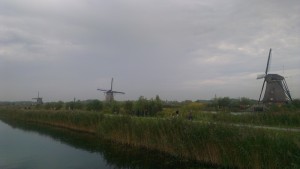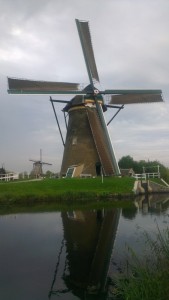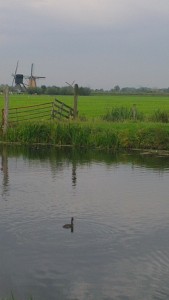It was Saturday afternoon in Alblasserdam and I’d finally managed to stop being lost. I considered wandering straight back to the Waterbus but I’d come this far and there was a a roadsign indicating that the windmills were just a few kilometers further, so I decided to keep going. It was a longer walk than I’d expected but I was walking along a pretty riverbank, with little Dutch houses on the other side of the road, so it quite pleasant. Not sure I’d recommend it to people not used to walking, however. Also, important to watch out for crazy cyclists.

Eventually, I reached Kinderdijk. The two sweet and elderly volunteers manning the ticket office were horrified that I’d walked all that way and directed me to a much easier (and 2.5km shorter) pedestrian (and cyclist) path I should take on the way back back.It’s just off the main road, a road filled with houses and museums and restaurants. Kinderdijk, located technically below sea-level, is a network of mills, dykes, pumping stations and reservoirs. It’s a water management system first constructed in the Middle Ages and still in operation today, although the windmills ceased to be the main method of pumping water in the 1950s. It is also a UNESCO World Heritage Site in recognition of “the outstanding contribution
made by the people of the Netherlands to the technology of handling water.. admirably demonstrated by the installations in the Kinderdijk-Elshout area”. Also, windmills!
Next to the ticket office was a small curio shop and restaurant. It was the same kind of curio shop/restaurant you so often see at historical places in South Africa – at least in the smaller towns. It was quite quaint and by this stage I was more than ready for a cup of coffee. Outside the window, a couple sat sharing a beer.
Feeling better, I wandered off to look at the windmills. As in pretty much all of Amsterdam, watch out for the cyclists and stay off their path – they’re quite determined. The windmills were stunning. The ones I was walking between were beautiful. Tall, buildings, thatched down the sides with giant blades reaching almost to the ground and as far above. They stand spaced along the canal in the grass.

I was fascinated to realise there were people living in the mills. It seems the mills have to kept in working condition – they’re even kept as the back-up to pump water if all other mechanisms fail – but they’re not in use most of the time, so families with young children sit and play outside their homes and wander along to visit their mill-dwelling neighbours. This afternoon, there was a man cleaning out his garage. Further along, another of the windmills was being re-thatched.
The sky was darkening and it was beginning to rain. Reluctantly, I walked across a bridge towards the pedestrian path. There were more windmills here. It was quieter here, with fewer tourists. Some of the people walking past were definitely locals. A last few magical windmills reflected in the water as the rain began to fall.
Before long, I was walking along the side of small canal, between houses, children playing in playgrounds and tall autumn trees. To the left, the view opened up and I was looking across green, green fields, cows grazing, windmills in the distance. On the water, ducks and swans and coots splashed and fished. So many people were walking their dogs. A little girl and a little boy rushed out towards the swings near their house and stopped just short of running into a swan. They’ll clearly met this kind of creature before and nervously eased their way past before rushing on. An old man, walking his dog spotted to chat to a man planting flowers. A woman with a wheelbarrow crossed a bridge to a cluster of allotments. It was a long walk and I was tired but it was pretty and peaceful.
At the other end the path, I recognized the church tower I’d seen earlier in the day and found my way back to the Waterbus station. I had about half an hour to spare, so I ducked back out into the drizzle and headed to a take away place I’d seen on earlier. The family running it was Korean. I found myself struggling to find a languages to greet them.
A rush back to the “bus” stop just as the boat arrived. As we headed back to Rotterdam, it began to rain in earnest. Fat drops splashing down around the boat and on the windows and the skylight. Past the buildings and sights and sounds, under the Erasmusbrug and we were back. I had been thinking of going out for dinner but it was warm and cozy at the backpackers. Out of the window, I watched a man in a suit, with his girlfriend on the back of his bicycle, arrive at a posh reception at the fancy restaurant, complete with huge plate glass windows, across the street.
That night I was staying in the Art Room(dorm) at ROOM Rotterdam, a lovely room painted white, with splatters of colour splashed around the walls and crockery and cutlery stuck to the ceiling. Tired but so pleased I’d managed to see the windmills, I slipped off to sleep.

